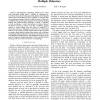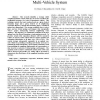1132 search results - page 110 / 227 » On coordination, autonomy and time |
CEC
2009
IEEE
14 years 4 months ago
2009
IEEE
— Automatically synthesizing behaviors for robots with articulated bodies poses a number of challenges beyond those encountered when generating behaviors for simpler agents. One ...
CIRA
2007
IEEE
14 years 4 months ago
2007
IEEE
— This research identifies a strategy called compliant formation control, which may be used to coordinate the navigational structure of a team of autonomous vehicles. This techni...
IROS
2007
IEEE
14 years 4 months ago
2007
IEEE
— When the tasks of a mission are interrelated and subject to several resource constraints, more efforts are needed to coordinate robots towards achieving the mission than indepe...
EUROMICRO
2006
IEEE
14 years 4 months ago
2006
IEEE
Instant messaging platforms facilitate coordination in workgroups by providing users with mutual information on their presence and availability, allowing for ad-hoc conversations ...
COORDINATION
2005
Springer
14 years 3 months ago
2005
Springer
With its decoupling of processes in space and time, the shared data space model has proven to be a well-suited solution for developing distributed component-based systems. However,...


